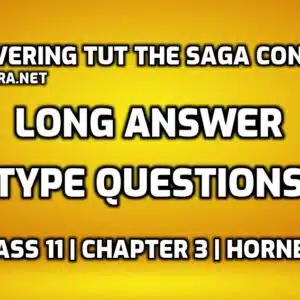
Discovering Tut the Saga Continues Long Answer are written by experts. Go through and gain confidence. We at edumantra highly appreciate your feedback regarding Discovering Tut Long Questions and Answers.
Discovering Tut the Saga Continues Long Answer
By- A.R. Williams
1. Who was Tut? Why is his life as well as death wrapped in mystery?
Ans. Tut was a teenager when he ascended the throne. He was the last heir of a powerful royal family. He was laid to rest 26 ft below the earth’s surface in a tomb. His mummy was discovered in 1922 by a British archaeologist, Howard Carter. He found a fabulous treasure in the tomb. The casket in which Tut’s body was laid, was made of pure gold.
Tut’s body was X-rayed and scanned to find out Tut’s age at the time of death and how he died. His life remained as great a mystery as his death. In 1968, the X-rays of the mummy showed a broken breastbone and some missing ribs. Tut’s untimely death at a young age is still a matter of research. How he died—whether under natural circumstances or unnatural ones—is still not confirmed.
[pt_view id=”601407df6s”]
2. What problems did Howard Carter face with regard to Tut’s mummy? How did he solve them?
Ans. Howard Carter, a British archaeologist, discovered King Tut’s tomb in 1922, after years of searching. He found fabulous treasures in the tomb, even though it had been ransacked earlier. The treasure consisted of a golden coffin, gold ornaments and even petty things of everyday need.
Carter found three coffins. In the first, he found the garlands of leaves and flowers. But when he reached the mummy, he ran into trouble. The resins used to embalm Tut’s body had hardened. The coffin was of solid gold. Neither human force nor the scorching sun could loosen the body.
So Carter used chisel and hammer to remove the resins. He had little choice. Tut’s mummy also had to be removed part by part. Having taken out the gold coffin, the body parts were reassembled, put in a wooden box and placed in the tomb again.
3. How did science help collect information about King Tut’s mummy, his life and death in mysterious circumstances?
Ans. King Tut’s mummy was first discovered in 1922 by Howard Carter. The embalmed of the boy king was buried in the tomb along with lots of gold ornaments, sandals masks and coffin—all of pure gold. His death was a big event. He was the last of powerful ruling family. But he died in mysterious circumstances at an early age, just nine years after his coming to the throne. In 1968, Tut’s body was X-rayed.
The anatomy professor’ found Tut’s breastbone and front ribs missing. But the researchers sought the help of advanced technology to solve the mystery. On January 2005, Tut’s head was pushed into a CT scanner. (The boy king had died 3,300 years ago) The operation took less than three hours. The pharaoh was rested in peace again. The mystery has not been resolved so far.
Value-Based questions
1. In 1922 Tut’s tomb was discovered. Much of the treasure buried in the tomb had already been plundered. The materialistic attitude of a man does not allow even the dead to sleep in peace. Will there be any end to this attitude? Discuss.
Ans. For a handful of gold, man can go to any extent. Tut’s mummy was buried deep in the desert with a lot of gold and other things believing that the dead Pharaoh would need those things in the afterlife. It was a matter of faith. When Tut’s tomb was discovered, much of the treasure had already been looted. The thieves did it being driven by the mad force of materialism.
Materialistic attitude attaches no importance to beliefs, religious sentiments and social rites and rituals. But when Carter finally succeeded in discovering Tut’s tomb, he found the richest royal collection—all made of solid gold—in the tomb. Even the coffin was made of gold. In order to remove Tut from his coffin, Carter had to cut the body from its joints. So, man doesn’t allow even the dead to sleep in peace.
2. The lesson ‘Discovering Tut’ allows us a peep into the past or history. For many, history is a dry subject but its study does make us wiser. What do you think?
Ans. Real history is the objective portrayal of events and facts that depicts development and destruction. True history is never coloured in the hues of politics. It reflects the myriad facets of society. Modern technology has made its portrayal objective. History puts forward lessons for us and provides us with chances to improve. So, itis true that those who do not pick up these lessons are condemned to repent.
Shrewd people have used history to rouse mass hysteria to grind their own axe. Distortion of history causes havoc in society. To the intelligent people, history is a window through which they peep into the past to collect facts and interpret them in an objective manner.
By and large, history is the study of past events, political, economic and social development of a country and many a time we feel belittled knowing that our forefathers were better than us in many respects. We can learn a lesson from them and refrain from making the same mistakes.
[pt_view id=”558fcdebgk”]